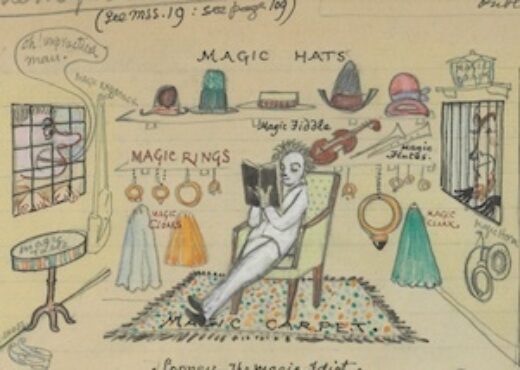
Printed
5 pages
Author(s)
Blue Sky
A Sketch for a Little Farce for Marionettes
The Drama for Fools is the project of a long cycle of puppet plays that kept Craig very busy between 1916 and 1918. It was supposed to hold 365 short plays and be performed like a traveling show: each night, from April 1st to March 31st, a new play was to be performed in a new location. Craig, who signed his plays under the nickname Tom Fool, stopped writing before the cycle was finished and gave up on performing the play himself. Nonetheless, he managed to keep his drafts in three cardboard boxes, as a collection of typewritten notebooks containing a myriad of illustrations and whose covers were calligraphed in different colors. He cared immensely for these notebooks: he improved, corrected, and added material to them until the 1950s. Nowadays, this collection belongs to the International Puppet Institute (Institut International de la Marionnette), based in Charleville-Mézières.
Blue Sky is one of the rare plays of the Drama for Fools that Craig actually published, in the March 1921 issue of the literary review The English Review. In footnotes, he presents the text as the work of Tom Fool, stating that the latter entrusted him with the text before he died – most likely a sign that, on that date, Craig renounced to complete his plan of writing 365 plays.The ridiculed thieves
Don Johnny Bernard Bull (alias Sly-Boots) and Don Taffy Muggins (alias Swagsman) are observing the inside of a house, each from a window. It is the house of Looney, “the Magic Idiot”, and it is full of magical objects. Sly-Boots enters to ask for a remedy, and Looney, who is a wizard, shows him how to create blue sky by mixing two different powders of his own invention. The process is too complicated for Sly-Boots, who refuses to buy it and blames him for trying to sell it at a ridiculous price. Taking advantage of Looney’s distraction, Sly-Boots steals his powders. Blind Boy arrives and shows Sly-Boots how he can see the future in a page of The English Review. He then creates blue sky with Looney; meanwhile, Cockatrice arrives in her turn.
In the village square, Sly-Boots meets up with Muggins. He wants them to try out the powder he has stolen, but it is not working: Sly-Boots falls asleep and dreams. Muggins goes to Looney and asks him to buy some powder; he learns that Sly-Boots has stolen another powder and can die from it. Because Muggins threatens him, Looney offers him a magic mirror to coax him. Looney shows Muggins how to make it with two pouches of powder and convinces him to leave his home without him noticing. Realizing that Looney tricked him, Muggins threatens him again, but Blind Boy and Looney begin to play the opening act of Mozart’s The Magic Flute. The song summons a king and a queen riding near a stream, and a blue moon rising in the sky. A silvery morning and gilded evening follow, then a Puppet turns to the audience to advise them to mindfully experience the music, and forget the thieves and the insane.
First performance
Signori, la marionnetta!, mise en scène de Michele Mirabella, marionnettes de Maria Signorelli. Rome, Teatro San Genesio, création, 14 mai 1980.
Publications and translations
The English Review, vol. 32, n°3, March 1921
Edward Gordon Craig, The Drama for Fools / Le Théâtre des fous. Montpellier: L'Entretemps, 2012.
Edward Gordon Craig, The Drama for Fools / Le Théâtre des fous. Montpellier: L'Entretemps, 2012.
(French)Marisa Maymone Siniscalchi (dir.), Il trionfo della marionetta. Testi e materiali inediti di Edward Gordon Craig. Roma: Officina Edizioni, 1980.
(Italian)
